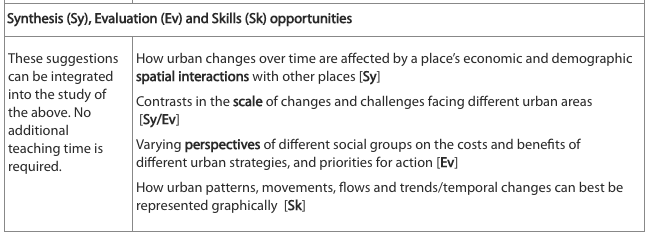Urban Environments
Sub Units
1. The variety of urban environments
2. Changing urban systems
3. Urban environmental and social stresses
4. Building sustainable urban systems for the future
2. Changing urban systems
3. Urban environmental and social stresses
4. Building sustainable urban systems for the future

Option G: Urban environments
More than 50% of the world’s population now lives in urban environments, with many living in megacities. This optional theme considers the hierarchy of cities and other urban places as sites of intense social interaction and as focal points of production, wealth generation and consumption. They exhibit diversity in patterns of wealth and deprivation, which can result in conflict. They may share common characteristics and processes irrespective of the national level of economic development.
Transport improvements have led to rapid growth and shifts in population and economic activities, producing stresses and challenges for urban planners. The theme also considers issues of sustainability, wherein cities need to be managed to minimize harmful social and environmental impacts.
Through study of this optional theme, students will develop their understanding of processes, places, power and geographical possibilities. They will additionally gain understanding of more specialized concepts including hierarchies (of settlements), systems (in relation to movements of people and the management of transport and waste flows) and sustainability.
More than 50% of the world’s population now lives in urban environments, with many living in megacities. This optional theme considers the hierarchy of cities and other urban places as sites of intense social interaction and as focal points of production, wealth generation and consumption. They exhibit diversity in patterns of wealth and deprivation, which can result in conflict. They may share common characteristics and processes irrespective of the national level of economic development.
Transport improvements have led to rapid growth and shifts in population and economic activities, producing stresses and challenges for urban planners. The theme also considers issues of sustainability, wherein cities need to be managed to minimize harmful social and environmental impacts.
Through study of this optional theme, students will develop their understanding of processes, places, power and geographical possibilities. They will additionally gain understanding of more specialized concepts including hierarchies (of settlements), systems (in relation to movements of people and the management of transport and waste flows) and sustainability.
|
|
|

